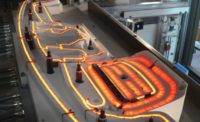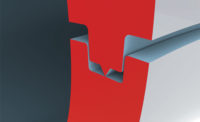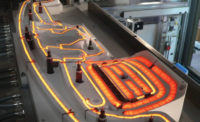If you make products that need to be taken apart for shipping, maintenance or repair, this article is not for you. This article examines some general applications and considerations for common fastening and joining techniques used in permanent part assembly.
There are many reasons products should not be taken apart:
- Personal safety. The product is inherently unsafe to repair.
- Operational safety. There’s a risk of liability if the product fails during operation.
- Extreme operating forces. The product is subject to shock, vibration or shear forces.
- Regulatory or warranty requirements. The part must be new, not repaired, as mandated by law or warranty requirements.
- Modular assemblies. The product contains permanently assembled components.
- Security and tamper-proofing. You just don’t want anybody messin’ with it.
Industries familiar with these concerns include automotive, medical, aerospace, aviation, electrical, power distribution, and defense. These concerns apply to any product where lives are on the line and product liability is high. These include air bag canisters, mountain climbing gear and fire extinguishers.
If your product doesn’t need to be taken apart, and you’re using a nonpermanent fastening method such as retaining rings, threaded fasteners, posts and cotter pins, you may want to consider permanent assembly. There are many advantages to permanent assembly methods:
- Reducing the cost of retaining rings, threaded fasteners, washers, cotter pins and other hardware.
- Reducing the costs of machining operations, such as machining grooves or drilling and tapping holes.
- Reducing cycle time. Forming a rivet or post takes less time than installing a retaining ring or driving a screw.
- Superior retention, compared with cotter pins, retaining rings and thread-lockers.
- Improved aesthetics. A formed head is more aesthetic than bolt head or retaining ring.
Permanent fastening methods include orbital and radial forming, hot upset forming, impact riveting, and roller forming.
Orbital and Radial Forming
Orbital riveting and forming is a cold-forming process using a peen tool held at a fixed angle to create a sweeping line of pressure around the part, progressively forming the material with each rotation. Compared with a standard press, this process requires approximately 75 percent less force to form a head on a rivet or post. The orbital process can form mild steel solid rivets from less than 0.0625 inch to 1.5 inches in diameter. The orbital forming process creates a low-profile, aesthetically appealing finish, and allows for joint articulation in such assemblies as multi-tool pliers, automotive door hinges and casters.
Spiral riveting and forming, also known as radial forming, is similar to the orbital process, but the material is displaced from the center outward in a rosette pattern. This creates less side force than the orbital process, which can cause parts to wobble during forming. This is especially true when forming small-diameter rivets or long rivets that are not held rigid by the part or fixture during assembly. The spiral process is not recommended for semitubular or hollow rivets, because the peen loses contact with the part being formed.
As a rule of thumb, 90 percent of applications for spiral forming can be done with the orbital process, with lower maintenance costs. The complexity of the spiral tooling head’s planetary gear, thrust plate, and pressure cup significantly increases overall cost of ownership. However, for long, thin and unsupported rivets, spiral forming may be the better option.
In general, orbital forming has a longer reach, which can be further extended using a special 3- or 4-degree long-reach orbital head, or an orbital head extension. To form around obstructions, options include a C-frame orbital head with an antirotation device, an offset orbital head, or a modified peen with antirotation device. In addition, orbital heads can be configured to form multiple rivets simultaneously, using multispindle or multipoint tooling heads.
Clamp loading will vary based on what is being formed (a tenon or rivet), the type of material, the tooling, and how the part is fixtured. (See illustration.) For example, if the part is supported, allowing a gap between the newly formed head and the part, the final joint will allow the rivet to float and will not provide any compressive loading. If the formed rivet head is supported, eliminating the gap between the part and the rivet, the joint will exhibit compressive loading. To improve clamp loading, options include applying a pressure pad to preclamp the part, increasing the advance rate of the forming head, or using an orbital head with a reduced attack angle to increase downward force.
Both orbital and spiral processes are recommended for low-profile joints requiring articulation, because they form the rivet head without completely collapsing the shank. Clamp load can be adjusted to maintain some rotational torque or friction, as required in applications such as surgical scissors. Retaining rings and cotter pins allow articulation, but do not provide compressive loading. As a result, they allow vibration between the fastener and the parts.
If the joint requires superior clamp loading and torque control, one fastening option is to use a bolt and nut, and then orbitally form the bolt against the face of the nut, locking the nut in place. Another option is to orbitally ring-stake the nut into the bolt’s threads to permanently lock them together. This additional operation adds to the production cost and reduces throughput. As a permanent solution, this is only recommended when extreme clamp loading and precise torque control is needed.
Hot Upset Forming and Riveting
The hot upset forming and riveting process uses heat and pressure to form the fastener. Similar to electroforging, the heated material becomes malleable and collapses under pressure applied by the powerhead. With this process, it is possible to form a round fastener into a square hole, creating a high-torque joint. Unlike welding, the base material does not bond with the fastener in most cases, though bonding can occur, depending on the material. In addition, this process may change the microstructure of the material being formed, altering its metallic properties. Testing the rivet or formed material is recommended.
As a rule of thumb, hot upset forming is best-suited for hardened materials that cannot be formed by other methods. This unique process provides greater hole-fill—over 98 percent—increases push-out force, and creates an overall tighter joint due to molecular contraction during cooling. This process is not recommended for joints that require articulation. It may also affect the aesthetics of surface coatings. Example applications include automotive striker-wires, ball studs and military weaponry.
Hot upset forming typically has a 3 to 4 second cycle time, which is generally slower than orbital or impact riveting. In addition, hot parts require special handling considerations. DC-powered systems are more efficient and precise than their AC counterparts, but come at a higher initial cost. Cost of ownership includes power consumption and tooling electrodes. Hot upset systems also require a chiller to maintain optimal tooling temperature.
Impact Riveting
Impact riveting is a cold-forming assembly process using pneumatic, electromechanical, hydropneumatic or hydraulic force to install a rivet. Joint characteristics can vary greatly depending on the rivet type, material and geometry. Some common rivet types include solid, semitubular and self-piercing. The forming sequence is unique to each type of rivet. The shank on a solid rivet must swell to fill the hole before the head collapses. On a semitubular rivet, the hollow tenon curls over on impact, drawing the parts together with minimal shank swell.
Self-piercing rivets are used to join sheet metal and other thin materials. These rivets pierce the upper layers of material until the bottom layer is displaced into a pocket in the anvil, creating a button shape similar to clinching. This process eliminates the cost of machining a hole, but with the absence of a hole, some applications may require external fixturing to align the parts.
Impact riveting machines have a much quicker cycle time than orbital, spiral and hot upset forming machines. They are commonly used for high-volume commodity products, such as heating and air-conditioning ductwork, brake pads and circuit breakers.
Impact machines are typically equipped with automatic rivet feeding systems, eliminating manual rivet handling and making it easy to install multiple rivets in a single part. In most cases, the operator handles the part, so there is no cost for part fixturing. High-capacity impact machines can install solid rivets up to 0.625 inch in diameter. Perishable tooling includes jaws, drivers and rollsets.
For high-volume assembly of brittle materials, such as clutch assemblies, circuit boards and plastics, riveting machines can be configured with load-deflecting components. To consolidate equipment and reduce the work area footprint, a single machine can be configured to install up to four rivets simultaneously. Other options for installing multiple rivets include dual-head and multihead machines. Using an offset driver accessory, riveting heads can be positioned as close as 0.0625 inch between rivet heads.
Roller Forming
Another permanent fastening method is roller forming. Specifically designed for assembling large-diameter parts, roller forming is a nonimpact process using a spinning roller-head with two or more rollers to apply a symmetrical force to the part. Roller forming is used for flaring, forming a lip, crimping, or forming a groove in cylindrical parts too large for other processes. Applications include water pumps, bearings, ball joints, air bag canisters, electrical sensors, fuses and solenoids.
As a general rule, 90 percent of all roller forming applications are between 0.375 and 6 inches in diameter. Wall thickness can vary from 0.03125 to more than 0.25 inch, depending on the material. The roller-head speed and advance rate are controlled by a powerhead configured with an integrated load cell and linear transducer for process monitoring and control. For part clamping, a through-spindle pressure pad option is available. For static roller-heads, typical cycle times range from 3 to 5 seconds depending on the application.
Articulating roller-heads are used for navigating around part obstructions and applying horizontal pressure for crimping or grooving applications. Pneumatically actuated articulating roller-heads can deliver a horizontal force up to 5,000 pounds at 100 psi. Typical cycle times for an articulating roller-head range from 4 to 10 seconds, depending on the application.
Because it applies nonimpact, symmetrical loading and offers precision control, roller forming can be used to form a retaining lip over glass or other brittle materials. Roller forming can also replace multipoint crimping with a full 360 degrees of contact retention. If a torque-resistant interface is required, rough or knurled mating surfaces are needed to grip against the formed lip or groove. In some cases, this process can replace welding to provide a strong joint with an aesthetically appealing finish, reducing production time and assembly cost. Sealing characteristics depend on the part’s design and usually requires the addition of a gasket or O-ring. Customer testing is highly recommended.







